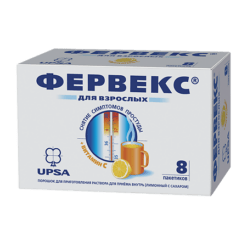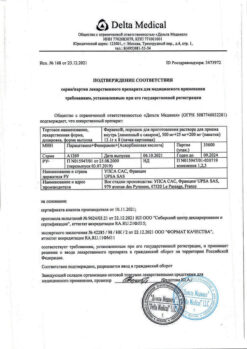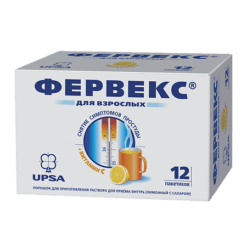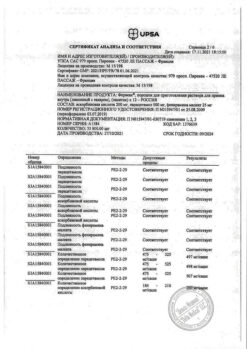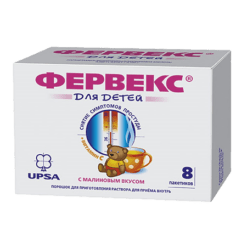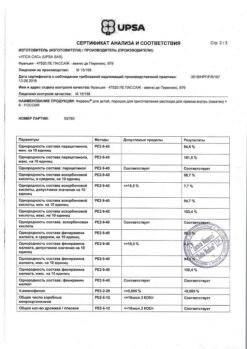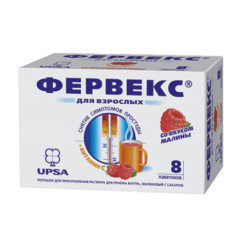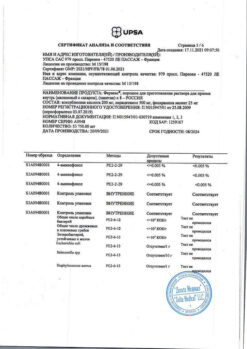No products in the cart.
Fervex [lemon], lemon b/sugar 12 pcs
€1.00
Out of stock
(E-mail when Stock is available)
Description
Pharmacotherapeutic group:
Medication for relieving symptoms of acute respiratory diseases (ARI) and “colds” (analgesic non-narcotic + H1-hisgamine receptor blocker + vitamin).
ATX code:
N02BE51.
Pharmacological properties
Pharmacodynamics
Fervex® is a combined drug that contains paracetamol, pheniramine and ascorbic acid. Paracetamol is a non-narcotic analgesic, blocks cyclooxygenase, mainly in the central nervous system, affecting the centers of pain and thermoregulation; has analgesic and antipyretic effects.
Pheniramine is a blocker of H1-histamine receptors, decreases rhinorrhea and tearing, eliminates spasticity, edema and hyperemia of the nasal cavity mucosa, nasopharynx and sinus cavities. Ascorbic acid is involved in the regulation of redox processes, carbohydrate metabolism, blood coagulation, tissue regeneration, the synthesis of steroid hormones, reduces vascular permeability, reduces the need for vitamins B1, B2, A, E, folic acid, pantothenic acid. Improves tolerance of paracetamol and prolongs its action (associated with prolongation of T½).
Pharmacokinetics
Paracetamol
After oral administration is rapidly absorbed from the gastrointestinal tract. Maximum drug concentrations in the blood plasma are reached 10-60 minutes after ingestion. It is rapidly distributed throughout the body tissues and penetrates through the blood-brain barrier. Binding to plasma proteins is insignificant and has no therapeutic value, but increases with increasing dose.
Metabolism occurs in the liver, 80% of the dose is conjugated with glucuronic acid and sulfates to form inactive metabolites; 17% undergoes hydroxylation to form 8 active metabolites, which conjugate with glutathione to form inactive metabolites. One of the hydroxylated metabolic intermediates exhibits hepatotoxic effects. This metabolite is neutralized by conjugation with glutathione, but it can cumulate and in case of paracetamol overdose (150 mg paracetamol/kg or 10 g oral paracetamol) cause hepatocyte necrosis. It is excreted by the kidneys as metabolites, mainly as conjugates. Less than 5% of the dose taken is excreted unchanged. Elimination half-life is 1 to 3 hours.
Pheniramine:
It is well absorbed in the digestive tract. The elimination half-life from blood plasma is one to one and a half hours. It is eliminated from the body mainly through the kidneys.
Ascorbic acid:
It is well absorbed in the digestive tract. Time of maximum therapeutic concentration (TSmax) after oral administration – 4 hours. It is metabolized mainly in the liver. It is excreted by the kidneys through the gut, with sweat, unchanged and as metabolites.
* Flavoring composition: maltodextrin, acacia gum, α-pinene, ß-pinene, limonene, γ-terpinene, linalool, neral, α-terpineol, geranial, dextrose, silicon dioxide E551, butylhydroxyanisole.
Indications
Indications
It is used in acute respiratory diseases, acute respiratory viral infections, rhinopharyngitis to relieve the following symptoms:
Active ingredient
Active ingredient
Composition
Composition
How to take, the dosage
How to take, the dosage
Interaction
Interaction
Ethanol increases the sedative effect of antihistamines (pheniramine), therefore its intake during treatment with the drug Feverex® should be avoided. In addition, ethanol in concomitant use with pheniramine promotes acute pancreatitis,
Pheniramine in the preparation Fervex ® enhances the sedative effects: morphine derivatives, barbiturates, benzodiazepine and other tranquilizers, neuroleptics (meprobamate, phenothiazine derivatives), antidepressants (amitriptyline, mirtazapine, mianserine), antihypertensive drugs of central action, sedatives belonging to H1-blockers, and baclofen, which not only increase sedation, but also increase the risk of side effects of the drug (urinary retention, dry mouth, constipation).
The possibility of increased central atropine-like effects when used in combination with other agents with anticholinergic properties (other antihistamines, antidepressants of the imipramine group, phenothiazine-type neuroleptics, m-choline blocking antiparkinsonics, atropine-like antispasmodics, disopyramide) should be considered.
When using the drug together with inducers of microsomal oxidation: barbiturates, tricyclic antidepressants, anticonvulsants (phenytoin), flumecinol, phenylbutazone, rifampicin and ethanol, the risk of hepatotoxic effects increases significantly (due to the included paracetamol).
Glucocorticosteroids when used concomitantly increase the risk of glaucoma. Concomitant use with salicylates increases the risk of nephrotoxic effects. Concomitant use with levomycetin (chloramphenicol) increases the toxicity of the latter.
Paracetamol contained in the drug increases the effect of indirect anticoagulants and reduces the effectiveness of uricosuric drugs.
Ascorbic acid increases the blood concentration of benzylpenicillin and tetracyclines; at a dose of 1 g / day increases the bioavailability of ethinylestradiol (including those included in oral contraceptives). Improves intestinal absorption of iron preparations (converts trivalent iron to divalent iron); may increase iron excretion in concomitant use with deferoxamine. Reduces the effectiveness of heparin and indirect anticoagulants. Concomitant use with acetylsalicylic acid (ASA) increases urinary excretion of ascorbic acid and decreases excretion of ASA. Asc reduces the absorption of ascorbic acid by about 30%. Increases the risk of crystalluria during treatment with salicylates and short-acting sulfonamides, slows renal excretion of acids, increases excretion of alkaline drugs (including alkaloids), reduces the blood concentration of oral contraceptives. Increases total clearance of ethanol, which in turn reduces the concentration of ascorbic acid in the body. Quinoline drugs, calcium chloride, salicylates, glucocorticosteroids deplete ascorbic acid during long-term use. When concomitant use ascorbic acid reduces chronotropic effect of isoprenaline. With long-term use or use in high doses may interfere with the interaction of disulfiram and ethanol. In high doses increases excretion of mexiletine by the kidneys. Barbiturates and primidone increase urinary excretion of ascorbic acid. Reduces the therapeutic effect of neuroleptics – phenothiazine derivatives, tubal reabsorption of amphetamine and tricyclic antidepressants.
Special Instructions
Special Instructions
Contraindications
Contraindications
Kidney failure, congenital hyperbilirubinemia (Gilbert, Dubin-Johnson and Rotor syndromes), viral hepatitis, alcoholic hepatitis, advanced age.
Side effects
Side effects
Overdose
Overdose
Symptoms caused by paracetamol.
In overdose, intoxication is possible, especially in elderly patients, children, patients with liver disease (caused by chronic alcoholism), in patients with malnutrition, as well as in patients taking microsomal liver enzyme inducers, which may develop fulminant hepatitis, liver failure, cholestatic hepatitis, in the above cases – sometimes with fatal outcome. The threshold of overdose in these categories of patients may be lower. The clinical picture of acute overdose develops within 24 hours after taking paracetamol.
Symptoms: gastrointestinal disorders (nausea, vomiting, decreased appetite, feeling of discomfort in the abdomen and (or) abdominal pain). pale skin. When administered to adults 7.5 g or more or children more than 140 mg/kg at a time, cytolysis of hepatocytes with complete irreversible liver necrosis, development of liver failure, metabolic acidosis and encephalopathy occurs, which may lead to coma and death. 12-48 hours after paracetamol administration there is an increase in the activity of microsomal liver enzymes, lactate dehydrogenase, bilirubin concentration and decrease in prothrombin concentration. Clinical symptoms of liver damage appear 12-48 hours after overdose of the drug and reach their maximum on the 4th-6th day.
Treatment:
Immediate hospitalization. Gastric lavage during the first hours of poisoning, administration of enterosorbents (activated carbon, lignin hydrolysis). Determination of the quantitative content of paracetamol in blood plasma before treatment as early as possible after overdose. Administration of SH-group donators and precursors of glutathione synthesis – methionine and acetylcysteine – is most effective during the first 8 hours. The need for additional therapeutic measures (further administration of methionine, intravenous administration of acetylcysteine) is determined depending on the concentration of paracetamol in the blood. and the time elapsed after its administration.
Symptomatic treatment. Laboratory studies of the activity of microsomal liver enzymes should be performed at the beginning of treatment and then – every 24 hours. In most cases, microsomal liver enzyme activity normalizes within 1-2 weeks. In very severe cases, liver transplantation may be required.
Symptoms caused by pheniramine.
The signs of pheniramine poisoning are seizures, impaired consciousness, coma. If symptoms of poisoning occur, stop using the drug immediately and seek medical attention. Washing of the stomach, intake of enterosorbents (activated carbon, lignin hydrolysis), intravenous or oral administration of antidote acetylcysteine (if possible, during the first 10 hours after overdose), symptomatic treatment are recommended.
Similarities
Similarities
Additional information
| Shelf life | 3 years. |
|---|---|
| Conditions of storage | At a temperature of 15 to 25°C. . |
| Manufacturer | UTSA SAS, France |
| Medication form | Powder for preparation of solution for oral administration |
| Brand | UTSA SAS |
Other forms…
Related products
Buy Fervex [lemon], lemon b/sugar 12 pcs with delivery to USA, UK, Europe and over 120 other countries.

![Fervex [lemon], lemon b/sugar 12 pcs Fervex [lemon], lemon b/sugar 12 pcs](https://ru-pills.com/wp-content/uploads/2022/12/204097.png)
